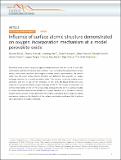| dc.contributor.author | Riva, Michele | |
| dc.contributor.author | Kubicek, Markus | |
| dc.contributor.author | Hao, Xianfeng | |
| dc.contributor.author | Franceschi, Giada | |
| dc.contributor.author | Gerhold, Stefan | |
| dc.contributor.author | Hutter, Herbert | |
| dc.contributor.author | Fleig, Juergen | |
| dc.contributor.author | Franchini, Cesare | |
| dc.contributor.author | Diebold, Ulrike | |
| dc.contributor.author | Schmid, Michael Sebasti | |
| dc.contributor.author | Yildiz, Bilge | |
| dc.date.accessioned | 2019-03-25T14:13:08Z | |
| dc.date.available | 2019-03-25T14:13:08Z | |
| dc.date.issued | 2018-09 | |
| dc.date.submitted | 2018-06 | |
| dc.identifier.issn | 2041-1723 | |
| dc.identifier.uri | http://hdl.handle.net/1721.1/121072 | |
| dc.description.abstract | Perovskite oxide surfaces catalyze oxygen exchange reactions that are crucial for fuel cells, electrolyzers, and thermochemical fuel synthesis. Here, by bridging the gap between surface analysis with atomic resolution and oxygen exchange kinetics measurements, we demonstrate how the exact surface atomic structure can determine the reactivity for oxygen exchange reactions on a model perovskite oxide. Two precisely controlled surface reconstructions with (4 × 1) and (2 × 5) symmetry on 0.5 wt.% Nb-doped SrTiO3(110) were subjected to isotopically labeled oxygen exchange at 450 °C. The oxygen incorporation rate is three times higher on the (4 × 1) surface phase compared to the (2 × 5). Common models of surface reactivity based on the availability of oxygen vacancies or on the ease of electron transfer cannot account for this difference. We propose a structure-driven oxygen exchange mechanism, relying on the flexibility of the surface coordination polyhedra that transform upon dissociation of oxygen molecules. | en_US |
| dc.description.sponsorship | Austrian Science Fund (SFB “ Functional Oxide Surfaces and Interfaces ” - FOXSI, Project F 45) | en_US |
| dc.description.sponsorship | European Research Council Advanced Grant (“OxideSurfaces” (Project ERC-2011-ADG_20110209)) | en_US |
| dc.description.sponsorship | National Science Foundation (U.S.). Division of Materials Research (CAREER Award Grant No. 1055583) | en_US |
| dc.publisher | Nature Publishing Group | en_US |
| dc.relation.isversionof | http://dx.doi.org/10.1038/s41467-018-05685-5 | en_US |
| dc.rights | Creative Commons Attribution 4.0 International license | en_US |
| dc.rights.uri | https://creativecommons.org/licenses/by/4.0/ | en_US |
| dc.source | Nature | en_US |
| dc.title | Influence of surface atomic structure demonstrated on oxygen incorporation mechanism at a model perovskite oxide | en_US |
| dc.type | Article | en_US |
| dc.identifier.citation | Riva, Michele, Markus Kubicek, Xianfeng Hao, Giada Franceschi, Stefan Gerhold, Michael Schmid, Herbert Hutter, et al. “Influence of Surface Atomic Structure Demonstrated on Oxygen Incorporation Mechanism at a Model Perovskite Oxide.” Nature Communications 9, no. 1 (September 13, 2018). | en_US |
| dc.contributor.department | Massachusetts Institute of Technology. Department of Aeronautics and Astronautics | en_US |
| dc.contributor.department | Massachusetts Institute of Technology. Department of Materials Science and Engineering | en_US |
| dc.contributor.department | Massachusetts Institute of Technology. Department of Nuclear Science and Engineering | en_US |
| dc.contributor.mitauthor | Schmid, Michael Sebasti | |
| dc.contributor.mitauthor | Yildiz, Bilge | |
| dc.relation.journal | Nature Communications | en_US |
| dc.eprint.version | Final published version | en_US |
| dc.type.uri | http://purl.org/eprint/type/JournalArticle | en_US |
| eprint.status | http://purl.org/eprint/status/PeerReviewed | en_US |
| dc.date.updated | 2019-03-04T14:23:45Z | |
| dspace.orderedauthors | Riva, Michele; Kubicek, Markus; Hao, Xianfeng; Franceschi, Giada; Gerhold, Stefan; Schmid, Michael; Hutter, Herbert; Fleig, Juergen; Franchini, Cesare; Yildiz, Bilge; Diebold, Ulrike | en_US |
| dspace.embargo.terms | N | en_US |
| dc.identifier.orcid | https://orcid.org/0000-0002-5096-5236 | |
| dc.identifier.orcid | https://orcid.org/0000-0002-2688-5666 | |
| mit.license | PUBLISHER_CC | en_US |
